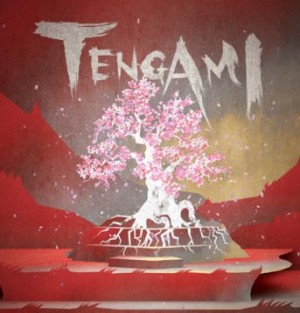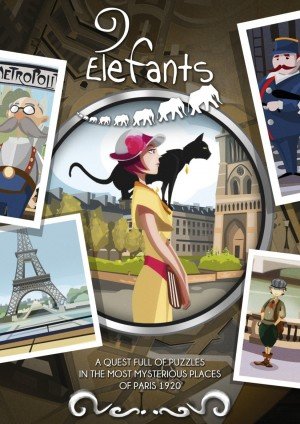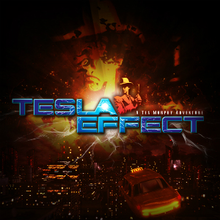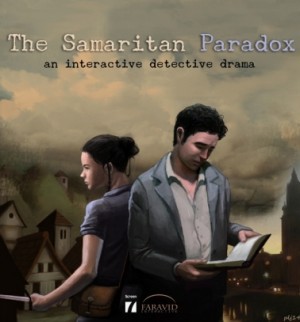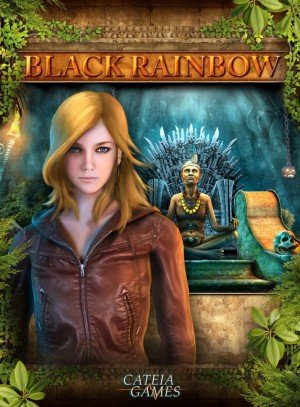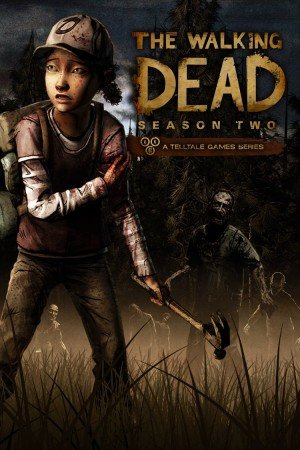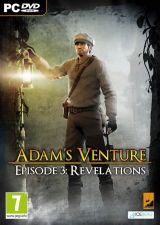Review for The Capri Connection page 2
The Capri Connection is the third game in the scenic series by the father-son team of Gey and Silvio Savarese. For this particular offering, Gey has taken over the reins of development solo, creating an adventure that branches out from the titular island, starting with a leisurely journey through Parco Virgiliano, the “Park of Remembrance.” Stone terraces along the clifftops overlook the harbor and the dark teal sea. Wildflowers are in bloom, and rows of evergreens display bizarre shapes sculpted by the ocean breeze. Years ago, I played partway into each of the preceding games – A Quiet Weekend in Capri and Anacapri: The Dream – but never finished them. Those two Capri games left me with memories of great natural beauty, tough puzzles, and the conviction that I had absolutely no idea where I was headed or what was going on. For better and for worse, The Capri Connection maintains this tradition, though of course this time I persevered through to the end.
The story: In Universe 3 (the universe of the game), a scientist named Costanzo Gravitiello has accidentally created a Space-Time Rip. This Rip has sent certain landmarks from our world (Universe 1) into the gameworld (Universe 3). So, for example, a famous American bridge appears and disappears and reappears between the islands of Procida and Vivara off the Italian coast. There are a couple of other landmark displacements, but they are rare. Why these structures in particular have swapped themselves between universes is not explained.
The Space-Time Rip has also switched certain people’s minds from one universe to another, placing them in their counterparts’ bodies. You are Nico Fredi, the hero from Anacapri, and you are suddenly shifted into the body of Nick Freuds in Universe 3. You receive a phone call, indicating that you are the only person who can heal the Rip, which is expanding rapidly. You must teleport to various places using an antique refrigerator device called the Frigo-T. In your travels, you will search for Professor Gravitiello while keeping your eyes peeled for colorful crystals that are part of an invention that might close the Rip.
The game’s story elements come at you in bursts, set apart by long periods of exploration. The story progresses chiefly through conversations with various characters. You are hindered in your quest by people in Universe 3 who are enjoying the company of the Universe 1 counterparts. An example – the former wife of the King of Capri, who now finds that the switch-er-ooed King is actually happy to pay her alimony.
You are further helped or hindered in your quest by everyday residents of Universe 3 who know all about the ominous Rip. They cooperate only if you solve puzzles for them. Some are aware that time is of the essence, but that doesn’t stop them from testing your brain before they’ll assist you. And once you’ve solved the puzzle or filled out their quiz, they rush off to an appointment, so they can’t help you any further.
An extra layer of story complexity is added by fictional characters whose minds have been transferred from off the page into the bodies of real people. These are supplemented by historical figures who are traveling through time and show up (much to their own astonishment) dressed in modern clothing. Mythological and fairy-tale creatures make surprise appearances (though these have managed to keep their traditional costumes). Even a Space-Time Rip is an insufficient explanation for this weird smorgasbord of characters. For Universe 3, anything goes, whether or not it makes any sense.
Conversation with this all-inclusive set of non-player characters is entirely one-sided – the game contains no dialog trees and you have no input at all, so dialogs are effectively monologues. Occasionally the characters pause and repeat a question you supposedly asked, and then answer it. This creates a facade of interaction, without the satisfaction of actually having any.
The characters are not animated, but posed via static photographs as voiceovers play in the background. They appear to be typical Italians, some (according to the credits) “…interpreting themselves as in their real life.” The dialogs contain no subtitles and cannot be clicked through. Sometimes they plod on for several minutes. Some of the dialogs are amusing, but others are weighted down by plot exposition. At times the language is stilted, with minor grammatical lapses.
The voiceovers range from acceptable to dreadful. A couple of characters sound exactly as though they are reading out loud from a book. The different accents make some words unintelligible. One dialog is performed entirely in a whisper – I didn’t understand a word of it. Conversations that are not only incomprehensible but unskippable as well become exercises in tedium. Fortunately, The Capri Connection allows you to go back and read the text of the dialogs. This is a lifesaver if you haven’t understood what a character has just said. To follow the story, I found it essential to read (and in some cases, re-read) these lengthy texts.
Looking past its convoluted story, what makes this game worth playing are the visuals, music, and puzzles. The Capri Connection uses a first-person perspective and a point-and-click interface. It features environments that consist of thousands of photographs presented in a slideshow-like format. These take you on long strolls through the streets, mountain paths, gardens, and forests near Naples.
As you wind your way back and forth through breathtaking landscapes, it’s hard not to conclude that this is one of the most beautiful spots on the face of the earth. You’ll encounter ancient marble statuary, pastel-colored villas stacked in terraced levels along the hillsides, and beaches tucked away between giant rock formations that march into the sea. Sometimes you enter a local home, art gallery, museum, or quaint restaurant in order to take in the ambiance. While there, you might pick up something useful or find a new bit of information, or you might even spot a tipsy Cumaean Sybil who spouts riddles.
Most of the locations lack animation, though water movement is sometimes animated, enhancing certain scenes. At particularly striking locations, you can access a mechanism that allows you to pan from left to right or top to bottom, displaying the entire sweep of the landscape.
Each individual screen contains a “U-turn” arrow that will turn you around 180 degrees, plus an arrow that will take you back one screen. Often something caught my eye just as I clicked to go forward, and it was handy to have an easy way to go back one step and examine the scene more thoroughly. These two arrows are ever-present and very easy to see.
However, the hotspots for the “go forward” directional arrows (letting you travel forward between screens) are much harder to find, because they are located in completely different places in each screen. Sometimes these inconsistent placements make sense (the arrow that’s atop the place where the path takes a turn, for instance). But as a consequence of this inconsistent placement, you’ll have to hunt for directional arrows with every step you take. There is a hotspot-finding feature, but even with that enabled the game contains a fair amount of pixel hunting. The delicate lines that reveal a hotspot are, from time to time, exactly the same color as the scene beneath them, making them effectively invisible.
Right-clicking brings up icons at the bottom of the screen that give access to the inventory, map, dialog texts and main menu. The start-up menu allows you to choose between two different visual modes – Center Screen, which has a high resolution but leaves black bars around the viewing area, and Full Screen, which fills the screen by stretching the images, making them ever-so-slightly blurry. The Instructions section in the main menu mentions that you can go into the Control Panel on your computer and play around with the screen resolution settings to sharpen the full screen images, though doing so can play havoc with the icons on your desktop.
Much of the game’s music was created by Kevin MacLeod, including the lilting, yet melancholic piano piece in Parco Virgiliano; the rhythmic, pulsing theme in the enchanted woods; and the jazzy melody that accompanies the stroll through Positano. The music in the Capri sequence was composed and performed by the talented Almartino, who appears in the game as himself, performing lively tunes on a selection of unusual instruments, including a giant flute. Music for each location plays on a rather long loop and then goes silent. Ambient sounds then emerge, so you’ll begin to hear the murmur of voices in the background, or the bubbling of a stream, or waves lapping the shore with seagulls calling.
The Capri Connection is a challenging game for several reasons. The large environments create a sense of immersion, but they also make it easy to lose one’s way – literally. The game map provides no help at all in navigating individual locations, and a decent map of each location would have made quite a difference. I spent a lot of time wandering about, picking a branch of the path to follow, then another, turning about, picking another path, and finally realizing that I had somehow come full circle.
The only way to know that you’ve finished a location is to go back and locate the Frigo-T and see if you can use it. If you can’t, then you must plunge back into the sprawling environments, searching for whatever it is that you’ve missed. Sometimes a conversation with a character will indicate what your goal should be, but often this means re-searching the large areas for something or someone whose appearance has just been triggered. At times the locations were so beautiful that I didn’t mind going in circles until I happened upon the directional hotspot that led to the side location where the next character awaited me. But I also experienced bouts of frustration where I finally consulted a walkthrough.
The puzzles are varied and engaging, include inventory challenges, quizzes, pattern analysis, and interpreting riddles, plus a range of self-contained puzzles. The standalone puzzles begin as items in inventory, which can be opened up to access the puzzle interface. In the early stages, these challenges are relatively easy (matching and spotting differences, for instance) but soon enough become quite difficult. The conundrum where colors can’t repeat horizontally, vertically, or diagonally was a true mind-bender. And the business with the little doors – not to mention the head-scratcher with the different mathematical operations – left me with less hair than when I started. Thankfully, clicking a “white flag” icon allows you to skip a puzzle. I confess to using it, though I won’t admit how often.
This game contains a couple of unexpected experiences – both good and bad. One oddity surfaced during gameplay when I was exploring the aquarium. Suddenly, the directional arrows disappeared. At first I clicked around wildly (my usual reaction to oddities), and finally concluded that, though the inventory was still accessible and the rest of the interface was functional, the game had crashed. I exited and searched the internet for any mention of a known glitch in the game and found none. Finally, I realized by consulting the walkthrough that I had missed a hotspot. For some reason, in the aquarium the game freezes you in place until you click on specific hotspots.
The Capri Connection features an Exploration Mode, which was a delightful surprise. I played the Exploration Mode after finishing the game. There’s a warning in the main menu that this mode contains spoilers, but I didn’t find it spoilerish. Actually, I was surprised at how much I relished its stress-free excursions, where I drank in even more details of the lovely surroundings. This mode, which eliminates all the puzzles and all the character interaction, plays like a tour of the area rather than a game. Unlike the game, it offers a quick travel component that returns you to the beginning of each location, eliminating much of the aimless wandering.
In the more than twenty hours that I spent with this game, I was dazzled by the beautiful sights and sounds (add me to the list of people who can’t wait to visit Naples and Capri). But at times I wandered, clueless, wondering what I’d missed or what was supposed to happen next. I was entertained by a variety of challenging puzzles, but I met verbose characters whose appearance, words, and actions seemed wildly incongruous in these hyper-realistic environments. In between, I tried to make sense of a story so tangled-up and whimsical that it soon became preposterous. Overall, The Capri Connection is a game of highs and lows, and your enjoyment will depend upon whether the allure of its locales and the gratification from solving its puzzles outweigh its inconsistencies.



_capsule_fog__medium.png)








